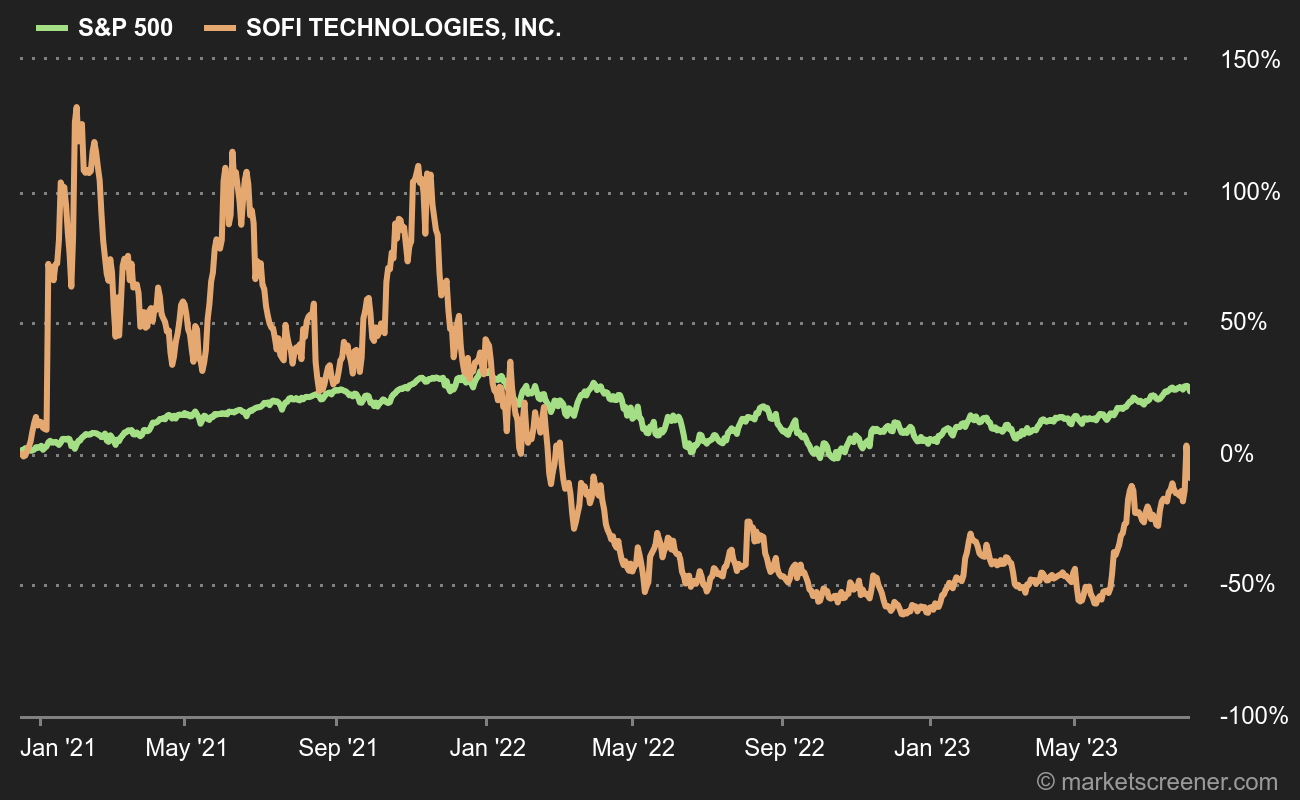SoFi Technologies is the talk of the town in the United States. With +120% expected by 2023, the stock is one of the Nasdaq's new stars. The stock recovered 20% on Monday to break the USD 10 barrier. The market has not entirely forgotten that the fintech was introduced via a SPAC in 2021 at a higher price. But given that the share price was USD 4.45 on May 15, it's fair to say that the recent run has been exceptional.
Not a bank... Oh, Wait!
The San Francisco-based company's reputation was initially built on its slick marketing to refinance loans for promising students in the US. Basically, the idea was to lure (young) customers by selling them a way out of daddy's banking system and into the wonderful world of fintech. This excellent business model enabled SoFi to develop with limited risk-taking, all the more so as rates were low and the clientele rather wealthy. So it's easy to see why the bankable name (the abbreviation SoFi stands for Social Finance) is only social when it comes to operating outside the traditional network, and not at all to financing the needy.
At last, bankable... At the outset, founder Mike Cagney insisted that his company would stick to its initial offering and cut the teeth of traditional banks without becoming one. This was intellectually accurate for a while, until SoFi diversified into all sorts of loans and services. The original narrative was definitively buried with the banking license SoFi applied for and obtained last year. But the marketing around fintech that is shaking up the sector remains relevant.
The beginning of something
The fact is that, after a series of disappointments, SoFi's good performance in recent months has not gone unnoticed. All the more so as they came at a time, it should be remembered, when the second- and third-fiddles of the US financial sector were struggling. Figures released on Monday show that revenues jumped by 37% to nearly $500 million in Q2, while net interest income more than doubled to $291 million. The bottom line of the income statement is still in deficit, but management has stated that SoFi will turn a profit from Q4 2023 onwards. All income statement items exceeded expectations. In addition, analysts praised the quality of the figures, particularly recurring revenues.
Annual targets were raised: symbolically for revenues, but more strongly for results, which is a sign of profitability going from strength to strength. "It's impressive to see that SoFi continues to expand its product range and user base, while navigating a difficult macro-economic and pricing environment", commented John Hecht, the analyst in charge of SoFi at Jefferies, at the beginning of July. At the time, the stock was trading at 8.10 USD, and Hecht was targeting 9.16 USD. In other words, he'll have to decide quickly whether to join the optimists or take a break.
After the publication, the division of the market into two clans was reinforced. On the one hand, there are the skeptics, who consider the valuation completely insane despite the undeniable progress made. And there are those who see SoFi as a future heavyweight in the financial sector. In fact, this is what the founder predicted eight or nine years ago, when he claimed a place in the top four financial services companies in the USA.
A win-win situation?
The latest results show that the fintech is making huge margins by taking advantage of the high interest-rate environment. In fact, they generally offer more attractive remuneration packages than their competitors, because their cost base is lower than that of a traditional bank. In so doing, they attract a large number of new customers, who in turn boost their deposits. Deposits that are used to finance new loans without going through the securitization process that was SoFi's original model. The result is an accelerating effect on earnings, visible in the aforementioned net interest income. As the company's CFO and some analysts have said, the company may also find itself at ease when rates fall. Indeed, thanks to its lean cost structure, it could guarantee higher levels of remuneration than the competition for longer, and thus still win customers on a falling tide, as it did on a rising one. It's like having your cake and eating it too.
Of course, it has to be like a dream. But it's an interesting case. And who knows, in a few years' time, Mike Cagney could be boasting of having his chair at the table of Jamie Dimon of JPMorgan Chase, Brian Moynihan of Bank of America and Charlie Scharf of Wells Fargo.




 By
By 










